CME: Light Therapy: Why, What, for Whom, How, and When (And a Postscript about Darkness)
Abstract
Abstract. Light therapy has become established as an evidence-based treatment for Seasonal Affective Disorder. Light impacts the timing and stability of circadian rhythms as expressed in sleep, mood, alertness, and cognition. Forty years of clinical trials and open treatment have led to guidelines for patient selection, using light alone or in combination with antidepressants (or lithium for bipolar depression). Mood and sleep disturbances can also respond to adjunct light therapy in a broader set of psychiatric, neurologic and medical illnesses. We specify criteria for choice of treatment devices: optimum dose (10,000 lux), spectrum (white light), exposure duration (30–60 minutes) and timing (early morning). Protocol adjustment requires continual monitoring with attention to rate of improvement and management of potential side effects.
Zusammenfassung. Die Lichttherapie hat sich als evidenzbasierte Behandlung der saisonal abhängigen Depression etabliert. Licht wirkt sich auf den Zeitpunkt und die Stabilität der zirkadianen Rhythmen aus, die sich in Schlaf, Stimmung, Wachsamkeit und Kognition äussern. Vierzig Jahre klinische Studien und offene Behandlung haben zu Leitlinien für die Auswahl der Patientinnen und Patienten geführt, die Licht allein oder in Kombination mit Antidepressiva (oder Lithium bei bipolarer Depression) verwenden. Stimmungs- und Schlafstörungen können auch bei einer breiteren Palette psychiatrischer, neurologischer und medizinischer Erkrankungen auf eine begleitende Lichttherapie ansprechen. Wir legen Kriterien für die Wahl der Behandlungsgeräte fest: optimale Dosis (10 000 Lux), Spektrum (weisses Licht), Expositionsdauer (30–60 Minuten) und Zeitpunkt (früh morgens). Die Anpassung des Protokolls erfordert eine kontinuierliche Überwachung, bei der der Grad der Besserung und das Management möglicher Nebenwirkungen berücksichtigt werden.
Abbreviations
NIMH National Institute of Mental Health
SAD Seasonal Affective Disorder
Light therapy is one of today’s most exciting and scientifically grounded medical developments. Although at first glance sounding like an alternative treatment from the California holistic scene, light therapy is the first treatment in psychiatry that developed directly out of basic neurobiology research. The use of light is only beginning to enter treatment guidelines for major depression (e.g., for bipolar disorder [1]) and circadian rhythm sleep disorders [2], although it is well established for Seasonal Affective Disorder (SAD) [3]. Clinical findings and major neuroscience discoveries have underscored the relevance of daylight and adequate indoor lighting for well-being, sleep, performance, and – in the long term – overall health. Thus, beyond medicine, this new knowledge has markedly influenced lighting research and product innovation, and architecture.
Why
Already 50 years ago, the field of chronobiology had expanded from a small, dispersed group of scientists studying daily (circadian) rhythms in fungi, mimosa leaves, fruit flies, mice, and humans, into a multifaceted discipline that recognised the universality of adaptation to the 24-hour day. Intrinsic circadian rhythms provide a predictive programme ensuring that every aspect of behaviour and physiology occurs at an optimum time. With the discovery of remarkably similar clock genes in all species, the importance of temporal order in evolution was underlined. Elucidation of how clock genes tick was granted the Nobel Prize for Physiology or Medicine in 2017, thus establishing the relevance of chronobiology and moving it from the fringe to the frontiers of science.
In addition to the day-night cycle, changes in daylength define the seasons and modulate seasonal rhythms in many species. Information about daylength is transduced from the eye to the brain and body by the pineal hormone melatonin, which is synthesised and secreted only at night (even in night-active species). In the early 1980s, physician-scientists at the US National Institute of Mental Health (NIMH) found that bright light suppressed melatonin in humans [4], whereas earlier this effect had been seen only in lab animals. The jump to our species provided a rationale for using light clinically to shift and stabilise circadian rhythms. The report, in “Science”, was read by Herbert Kern, a chemical engineer who had documented his recurring winter depressive episodes for more than twenty years. He perceived the link between light, seasonality, and his mood patterns, and became the first patient to be treated with bright artificial light at NIMH [5]. Their initial clinical trial verified the rapid efficacy of light as an antidepressant for seasonal syndrome, denoted SAD [6]. Following suit, we promptly turned to SAD studies in Switzerland [7, 8, 9, 10, 11], replicating and extending the NIMH results.
Only much later, a critical discovery revealed that light is not only important for vision (via the classical retinal rods and cones and optic nerve pathway to the brain), but that there is a non-visual pathway via novel photoreceptors in the retinal ganglion cells that directly accesses the circadian clock through a separate retinal-hypothalamic tract. These cells contain a photopigment, melanopsin, with highest sensitivity to short-wavelength, blue light. This is the major neural pathway by which light modulates the circadian system [12]. The more blue in a light source, for example, the stronger the effect on vigilance – advantageous during the working day, but detrimental in the evening and at night. The bluish hue of smartphone and TV screens, as prime examples, can interfere with sleep onset and continuity.
What
What do we mean by light therapy? We exclude here UV therapy for psoriasis and IR therapy for pain and inflammation. Light therapy in psychiatry and sleep medicine utilises lamps in the visible range, attaining a higher intensity (e.g. 10,000 lux white light) than conventional home lighting. The main evidence for efficacy of light therapy comes from light boxes. Pure blue wavelength devices are theoretically interesting but not superior to broad spectrum white light (and the glare is uncomfortable). Light helmets have been developed that do not require sitting at the light box for 30 minutes or longer, but few have shown reliable results. Some clinics have installed light rooms for group therapy, which allows free movement and social contact, but is impractical for treatment closely after waking, when the therapeutic action of light is strongest. Dawn simulation – incrementing low intensity light at the bed – is an effective alternative to bright light, but commercial devices are still not optimally designed.
Most lamps on the market have a smaller field of illumination than research devices and have not undergone clinical trials. Light therapy has become a “life-style drug” in a huge cottage industry without any government or research standards. All the more need for physicians to have an overview of the treatment paradigm to ensure correct use and dosage. The major factors are clinical efficacy, ocular and dermatologic safety, and visual comfort (Table 1).
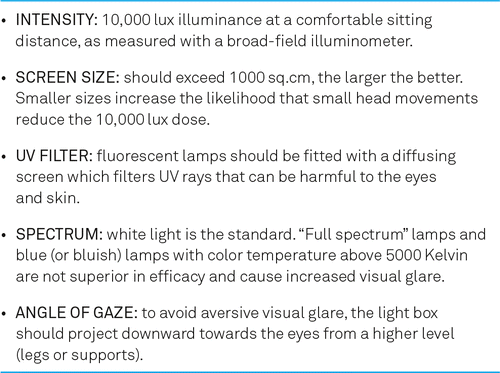
For whom
Light therapy was initially developed for SAD [6]. However, given the direct effect of light on mood, alertness, cognitive behaviour, and the ability of light to shift and stabilise the timing of sleep, the applications have broadened over the past few years.
The primary patient group of SAD is relatively easily diagnosed, since the majority show atypical neurovegetative symptoms compared with non-seasonal major depression (Table 2) [6]. Although they fulfil the criteria for major depression, the majority are not hospitalised, and are thus mostly seen in general practice. In addition, there is a larger group of patients with minor depression and a seasonal course (sub-syndromal SAD, or “winter blues”), who also profit from light therapy.
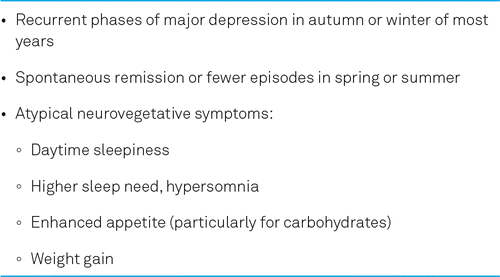
If we look at the prevalence of SAD in Switzerland in adults it is clear that there is a patient population (particularly women) that needs to be treated: overall 2.2 % of the population suffer from SAD and 8.9 % from sub-SAD [11]. A later prospective interview study of the Zürich cohort revealed 3.4 % SAD (5 × more women than men) [13].
A generation of international clinical trials in SAD is reviewed in recent meta-analyses e.g. [3]. Light improves depression in these patients within a couple of weeks. In non-seasonal affective disorders, longer durations are required for response, similar to the time required for antidepressant drugs [14, 15]. Several trials for other psychiatric and neurological disorders indicate mood and sleep improvement, e.g. our Basel studies [16, 17, 18, 19]. Given that mood and sleep disturbances are common in most psychiatric and medical illnesses, the use of light as an adjunct to conventional medication is indicated, though yet without sufficient studies (Table 3).
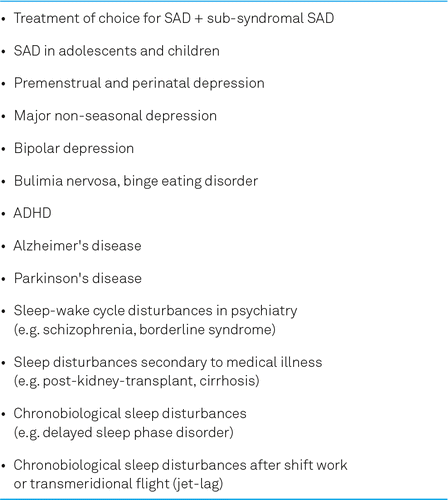
How
Light therapy for circadian and mood disturbances acts through the eye, not the skin. With protective diffusion screens, the lamps emit no UV or IR wavelengths, so there is no danger to the eye since the usual light intensity (10,000 lux) is that of the sky shortly after dawn (midday sun is around 100,000 lux). However, it is important to check ophthalmologic health and beware of photosensitising medication (e.g. St John’s wort) [20]. Light can be combined with ongoing antidepressants in both SAD and non-SAD, light often potentiating and accelerating the clinical response. However, it should be noted that SAD patients who have classical symptoms of insomnia and weight loss do not respond well to light therapy and require conventional treatment.
Dosing is defined by the amount of illumination attained when sitting at a specific distance defined by the manufacturer of the light box. Since light intensity rapidly diminishes with distance, even a slight head movement 10–20 cm away from the required distance reduces the dose. This point should be emphasised to patients to make sure they are not “undertreated”. The standard starting treatment for SAD patients is 10,000 lux for half an hour in the morning (precise individual timing augments response; see below). Response should be monitored closely. In SAD, improvement is seen rapidly, within two weeks. If no change is seen after this time, the dose can be increased by 15-minute increments every few days. For non-SAD patients, longer periods of 45–60 minutes/day are used. An obvious alternative, given the much higher daylight intensities outdoors, is a regular morning walk [9].
Side effects are minor, and in most patients usually disappear after a few days (Table 4).

When
Morning light shifts the circadian clock earlier, evening light later. Although light has some antidepressant effect at all times of day, the strongest mood elevation occurs with early morning light, specifically timed for the individual’s own circadian rhythms [21]. We have all heard of chronotypes who differ in their natural sleep timing – the morning lark and the evening owl. Evaluating chronotype with the MEQ Chronotype Questionnaire (https://cet.org/assessments/), available in 15 languages to download and fill out, with a guide to calculating score and interpretation, helps plan optimal treatment. Table 5 provides the start time of a 10,000 lux, 30-minute light therapy session across MEQ scores [22].
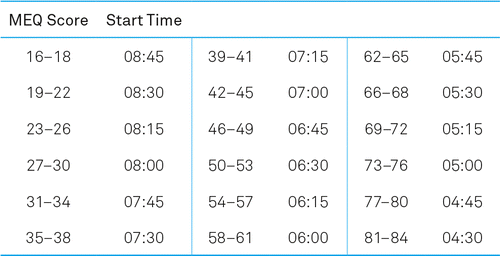
The importance of establishing each patient’s appropriate timing is shown in the remission rates to light therapy in SAD: the earlier the treatment, the more successful the response (Table 6) [21].
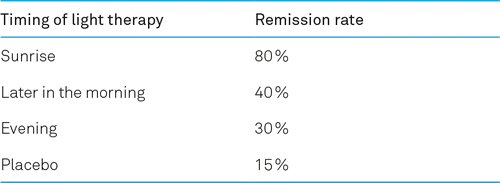
It may not be easy or practical to begin with the start time recommended by the MEQ score, since it is often earlier than the usual wake-up time. It is simplest to begin light therapy immediately after the usual wake-up time for a few days, then gradually shift the treatment to 15 minutes earlier until the required timing is reached. This becomes easier with time since morning light shifts sleep to earlier and facilitates compliance.
Finally, depression and sleep disturbances are widespread: What aspects of modern society might be responsible? Our environment contaminates the pristine illumination pattern of the solar cycle, and we rarely see the dawn-dusk twilights. The concepts underlying light therapy have been extended to everyday life, incorporating circadian components in lighting design to enhance sleep quality and wellbeing, and to promote health, particularly in schools, offices, hospitals, and nursing homes.
Postscript: darkness
When emphasising the importance of sufficient bright light exposure for the treatment of mood and sleep disorders, and indeed for the wellbeing in everyday life, the complementary requirement must not be forgotten: to have enough darkness at night. The day-night cycle has lost its primary format in our highly illuminated environments.
Clinically, it has been shown that rapid-cycling or manic bipolar patients can be treated by exposing them to 14 hours of darkness for extended nights [1]. A more practical solution is the use of amber glasses, which block the blue wavelengths crucial for shifting the circadian system, thus ensuring “virtual” darkness. Controlled clinical trials have shown that this surprisingly simple intervention is more efficacious than antimanic drug medication [1]. By using amber glasses and thus reducing excessive light exposure (mostly in the evening) sleep cycles and mood can be stabilized.
Since the pineal hormone melatonin is considered as the nighttime signal to prepare the organism for sleep, it is another form of “darkness”. Timed melatonin administration can shift and stabilise the sleep-wake cycle and is used for sleep dysregulation prevalent in the visually handicapped and blind (who cannot respond to light), for older people with sleep-onset problems, and for advancing the delayed sleep timing in young individuals [23]. The most well-known application of timed melatonin treatment is for jetlag-induced sleep misalignment [24].
Melatonin is of little use for primary insomnia and cannot be considered a sleeping pill. Melatonin acts as a synchronising agent and due to its direct effects on distal vasodilatation (inducing “warm feet”) enhances sleepiness and shortens sleep-onset time [25].
Case study
A 35-year-old woman came to the Basel Centre for Chronobiology because her history of major depressive episodes showed regular winter patterns. She began weekly depression self-ratings (6 = threshold for depression) (Figure 1). The first year illustrates the untreated natural course of the illness beginning in autumn and spontaneously remitting in spring, with low ratings all summer. Light therapy begun in January of the second year induced a lasting euthymia. In year three light therapy began earlier, thus cutting off most of the depressive episode until the spontaneous remission in April. Note that stopping light treatment in March resulted in a return of minor symptoms, even more clearly seen in year four. This long-term example illustrates the regularity of seasonal recurrence of depressive episodes and the rapid effect of light therapy (unpublished data, reprinted from [26]).

Further information
- •Practical manual [26]: Chronotherapeutics for affective disorders: A clinician’s manual for light and wake therapy, Anna Wirz-Justice, Francesco Benedetti, Michael Terman. www.karger.com/book/home/257464
- •www.cet.org online information about light therapy, questionnaires
- •www.daylight.academy multidisciplinary task force investigating the benefits of daylight
CME-Fragen
Teil 1: Fragen zu «CME: Light Therapy: Why, What, for Whom, How, and When (And a Postscript about Darkness)», S. 56
Im Jahr 2022 vergibt die SGAIM 1 Creditpunkt für die korrekte Bearbeitung (60 %) von zwei CME-Beiträgen pro «Praxis»-Ausgabe. Den zweiten CME-Beitrag finden Sie auf S. 63, den Antworttalon auf S. 75.
Frage 1. Welche wichtige Entdeckung legte den Grundstein für die Entwicklung der antidepressiven Lichttherapie? (Einfachauswahl)
- a)Helles künstliches Licht in der Nacht unterdrückte die Melatoninproduktion in der Zirbeldrüse.
- b)Gedämpftes Licht in der Morgendämmerung während des Schlafs unterdrückte die Melatoninproduktion in der Zirbeldrüse.
- c)Eine tagsüber dargebotene Periode der Dunkelheit regte die Melatoninproduktion der Zirbeldrüse an.
- d)Helles Licht in der Nacht unterdrückte die Melatoninproduktion der Zirbeldrüse nur bei Personen mit Depressionen, nicht aber bei normalen Kontrollpersonen.
- e)Patientinnen und Patienten mit Depressionen hielten die Melatoninproduktion während des Tages aufrecht.
Frage 2. Welche der folgenden Hauptmerkmale von Geräten zur Therapie mit hellem Licht wurden in klinischen Studien bei SAD, nicht-saisonaler Depression, bipolarer Depression und peripartaler Depression angewendet? (Einfachauswahl)
- a)Bildschirmgrösse ≥ 1000 cm2
- b)Der Bildschirm ist so positioniert, dass er nach unten auf die Augen projiziert wird.
- c)Beleuchtungsstärke ≥ 10 000 Lux in jeder Entfernung vom Bildschirm.
- d)Antworten a) und b) sind richtig.
- e)Antworten a) und c) sind richtig.
Frage 3. Für die Diagnose von SAD im Herbst/Winter müssen depressive Episoden wie folgt aufgetreten sein: (Einfachauswahl)
- a)Jährlich im Herbst und Winter, ohne Rückfall im Frühjahr und Sommer, während mindestens zwei aufeinander folgenden Jahren.
- b)Im Herbst und Winter der meisten Jahre, ohne Rückfall im Frühjahr und Sommer.
- c)Im Herbst und Winter in den meisten Jahren, mit vergleichsweise weniger Episoden im Frühjahr und Sommer.
- d)Auf sub-syndromalem Niveau, wenn die Kriterien für eine schwere depressive Störung nicht erfüllt sind.
- e)Mit Schlaflosigkeit, Appetitlosigkeit und Gewichtsverlust
Frage 4. Damit eine Therapie mit hellem Licht die SAD rückgängig machen kann, sollte die Behandlung wann beginnen? (Einfachauswahl)
- a)Bei den ersten Anzeichen einer beginnenden Episode, bevor der Schweregrad einer schweren Depression erreicht wird.
- b)Vor dem Auftreten von Gemütssymptomen, sobald atypische neurovegetative Symptome gemeldet werden.
- c)Jederzeit während der Herbst-/Winter-Episode, unabhängig vom Schweregrad der Symptome.
- d)a), b), und c) sind richtig.
- e)Antworten a) und c) sind richtig.
Frage 5. Um das Ansprechen auf die Lichttherapie bei Winterdepression aufrechtzuerhalten, sollte die Behandlung … (Einfachauswahl)
- a)… zwei Wochen lang beibehalten werden, danach wird erwartet, dass die klinische Verbesserung während der gesamten Saison anhält.
- b)… täglich während der gesamten Saison bis April fortgesetzt werden.
- c)… täglich fortgesetzt werden, wobei gelegentliche Tage ohne Lichttherapie möglich sind, wenn die Symptome nicht sofort wieder auftauchen.
- d)… täglich fortgesetzt oder kombiniert werden mit 30–60-minütigen Spaziergängen im Freien an Tagen mit klarem Wetter.
- e)Antworten b), c) und d) sind richtig (alle drei Optionen müssen berücksichtigt werden).
Frage 6. Wie wirkt Dunkelheit im Gegensatz zur Therapie mit hellem Licht therapeutisch? (Einfachauswahl)
- a)Sie verstärkt die Wirkung der morgendlichen Lichttherapie bei SAD.
- b)Sie beruhigt die Symptome einer Manie, unabhängig davon, ob sie saisonal oder nicht saisonal bedingt ist.
- c)Sie verstärkt die antimanische Wirkung der nächtlichen Melatoninproduktion.
- d)Sie verringert die Exposition gegenüber grünen, gelben, orangen und roten Wellenlängenbereichen des weissen Lichts.
- e)Antworten b) und d) sind richtig.
Bibliography
, The chronotherapeutic treatment of bipolar disorders: A systematic review and practice recommendations from the ISBD task force on chronotherapy and chronobiology. Bipolar Disord . 2019; 21 :741–773.
. Clinical practice guideline for the treatment of intrinsic circadian rhythm sleep-wake disorders: advanced sleep-wake phase disorder (ASWPD), delayed sleep-wake phase disorder (DSWPD), non-24-Hour Sleep-Wake Rhythm Disorder (N24SWD), and irregular sleep-wake rhythm disorder (ISWRD). An update for 2015: an American Academy of Sleep Medicine Clinical Practice Guideline. J Clin Sleep Med . 2015; 11 :1199–1236.
, The efficacy of light therapy in the treatment of Seasonal Affective Disorder: A meta-analysis of randomized controlled trials. Psychother Psychosom . 2020; 89 :17–24.
. Light suppresses melatonin secretion in humans. Science . 1980; 210 :1267–1269.
. Bright artificial light treatment of a manic-depressive patient with a seasonal mood cycle. Am J Psychiatry . 1982; 139 :1496–1498.
, Seasonal affective disorder. A description of the syndrome and preliminary findings with light therapy. Arch Gen Psychiatry . 1984; 41 :72–80.
. Light treatment of seasonal affective disorder in Switzerland. Acta Psychiatr Scand . 1986; 74 :193–204.
, Dose relationships of morning bright white light in seasonal affective disorders (SAD). Experientia . 1987; 43 :574–576.
, ’Natural’ light treatment of seasonal affective disorder. J Affect Disord . 1996; 37 : 109–120.
: Follow-up study of seasonal affective disorder in Switzerland. Psychopathology . 1997; 30 : 208–214.
. Seasonality in affective disorders in Switzerland. Acta Psychiatr Scand Suppl . 2003 ;(418):92–95.
. Melanopsin-positive intrinsically photosensitive retinal ganglion cells: from form to function. J Neurosci . 2011; 31 :16094–16101.
. Prevalence of seasonal depression in a prospective cohort study. Eur Arch Psychiatry Clin Neurosci . 2019; 269 :833–839.
, Light therapy for non-seasonal depression: systematic review and meta-analysis. B J Psych Open . 2016; 2 : 116–126.
. Efficacy of light therapy versus antidepressant drugs, and of the combination versus monotherapy, in major depressive episodes: A systematic review and meta-analysis. Sleep Med Rev . 2019; 48 : 101213.
, Dawn-dusk simulation light therapy of disturbed circadian rest-activity cycles in demented elderly. Exp Gerontol . 2003; 38 :207–216.
, A randomized, double-blind, placebo-controlled study of light therapy for antepartum depression. J Clin Psychiatry . 2011; 72 :986–993.
. Circadian sleep-wake cycles, well-being, and light therapy in borderline personality disorder. J Pers Disord . 2013; 27 :680–696.
, The effect of bright light therapy on sleep and circadian rhythms in renal transplant recipients: a pilot randomized, multicentre wait-list controlled trial. Transpl Int . 2015; 28 :59–70.
. Ophthalmologic examination of patients with seasonal affective disorder, before and after bright light therapy. Am J Ophthalmol 1995; 119 :202–210.
. Circadian time of morning light administration and therapeutic response in winter depression. Arch Gen Psychiatry . 2001; 58 :69–75.
. Light therapy for seasonal and nonseasonal depression: efficacy, protocol, safety, and side effects. CNS Spectrums . 2005; 10 :647–663.
. Melatonin and the circadian system: Keys for health with a focus on sleep. Handb Clin Neurol . 2021; 179 :331–343.
. Managing jet lag: Some of the problems and possible new solutions. Sleep Med Rev . 2009; 13 :249–256.
. Warm feet promote the rapid onset of sleep. Nature . 1999; 401 :36–37.
. Chronotherapeutics for affective disorders: A clinician’s manual for light and wake therapy . 2nd Edn. Basel; Karger: 2013. p.12.



